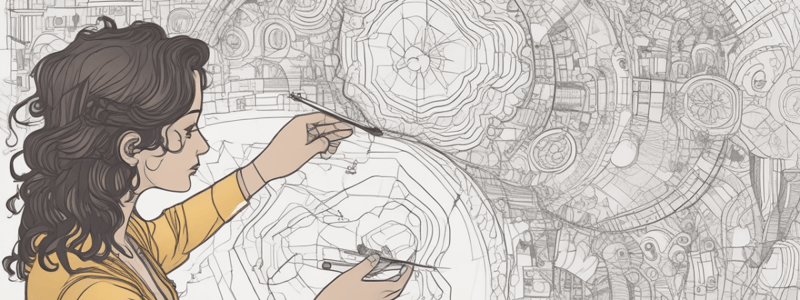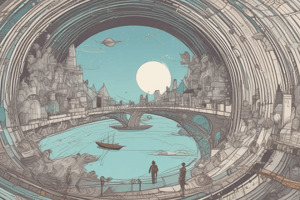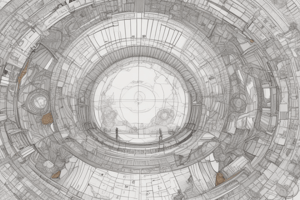Podcast
Questions and Answers
What is the primary goal of conducting research in design?
What is the primary goal of conducting research in design?
- To create a new product or service
- To develop a new business strategy
- To gather data for statistical analysis
- To understand the needs of users and create solutions to improve their lives (correct)
What is the typical distribution of people engaging in an activity?
What is the typical distribution of people engaging in an activity?
- Mostly extreme users
- A normal distribution with average users in the middle (correct)
- Only non-users
- Only lead users
What is the third area of research mentioned in the text?
What is the third area of research mentioned in the text?
- Obstacle courses
- Context
- Empathy
- Foresight (correct)
What is the purpose of understanding the context of users?
What is the purpose of understanding the context of users?
Who are considered lead users?
Who are considered lead users?
What is the benefit of studying lead users?
What is the benefit of studying lead users?
What is the benefit of using foresight in design?
What is the benefit of using foresight in design?
What is the term used to describe the process of making solutions more relevant for a larger population?
What is the term used to describe the process of making solutions more relevant for a larger population?
What is the purpose of conducting user interviews and observations?
What is the purpose of conducting user interviews and observations?
What is the benefit of having a mix of lead core and non-users in research?
What is the benefit of having a mix of lead core and non-users in research?
What is the famous example of democratizing design mentioned in the text?
What is the famous example of democratizing design mentioned in the text?
What is universal design all about?
What is universal design all about?
What is empathy in the context of design research?
What is empathy in the context of design research?
What is the purpose of trend definition in design research?
What is the purpose of trend definition in design research?
What is the famous example of universal design mentioned in the text?
What is the famous example of universal design mentioned in the text?
What is the purpose of conducting research in design?
What is the purpose of conducting research in design?
What is the result of designing solutions for extreme users or non-users?
What is the result of designing solutions for extreme users or non-users?
What is the importance of understanding the context of users in design?
What is the importance of understanding the context of users in design?
Why is it helpful to start design research with extreme users or non-users?
Why is it helpful to start design research with extreme users or non-users?
What is the common theme seen in the examples of democratizing design and universal design?
What is the common theme seen in the examples of democratizing design and universal design?
What key aspects did the first module of the Advanced Design Planning course cover?
What key aspects did the first module of the Advanced Design Planning course cover?
What analogy is used to describe the designer's approach to gathering information?
What analogy is used to describe the designer's approach to gathering information?
Why is it important for a designer to build a large fact base according to this module?
Why is it important for a designer to build a large fact base according to this module?
What is the significance of the professor's question about morning sunlight on the breakfast table?
What is the significance of the professor's question about morning sunlight on the breakfast table?
What is not mentioned as a benefit of having morning sunlight on the breakfast table?
What is not mentioned as a benefit of having morning sunlight on the breakfast table?
In the context of the module, what does 'altitude and approach' refer to?
In the context of the module, what does 'altitude and approach' refer to?
What trait is emphasized for designers in their research phase?
What trait is emphasized for designers in their research phase?
What does learning 'everything we can' about a problem help a designer achieve?
What does learning 'everything we can' about a problem help a designer achieve?
What is the primary focus when conducting an ethnographic interview with a stakeholder or user?
What is the primary focus when conducting an ethnographic interview with a stakeholder or user?
What is a challenge often faced by leaders or managers during ethnographic interviews?
What is a challenge often faced by leaders or managers during ethnographic interviews?
What is the significance of building rapport during an ethnographic interview?
What is the significance of building rapport during an ethnographic interview?
Why should specific stories be encouraged in the narrative step of ethnographic interviews?
Why should specific stories be encouraged in the narrative step of ethnographic interviews?
Which question would be most effective in eliciting a detailed response during an ethnographic interview?
Which question would be most effective in eliciting a detailed response during an ethnographic interview?
Why should an interviewer appear 'naive' during an ethnographic interview?
Why should an interviewer appear 'naive' during an ethnographic interview?
What type of questions should generally be avoided in an ethnographic interview?
What type of questions should generally be avoided in an ethnographic interview?
What should an interviewer do after hearing a story from the interviewee?
What should an interviewer do after hearing a story from the interviewee?
During the rapport-building stage, how long might it take relative to the total interview time?
During the rapport-building stage, how long might it take relative to the total interview time?
What phrase is recommended to encourage the interviewee to provide more details?
What phrase is recommended to encourage the interviewee to provide more details?
Why is Lipitor considered a blockbuster drug?
Why is Lipitor considered a blockbuster drug?
How do pharmaceutical developers approach product design?
How do pharmaceutical developers approach product design?
What is one key strategy McDonald's uses in understanding their customer base?
What is one key strategy McDonald's uses in understanding their customer base?
What is a significant aspect of McDonald's menu design?
What is a significant aspect of McDonald's menu design?
In what way does McDonald's innovate in their operations?
In what way does McDonald's innovate in their operations?
What lesson can be learned from McDonald's approach to customer research?
What lesson can be learned from McDonald's approach to customer research?
Why is it important to also consider your customer's customer?
Why is it important to also consider your customer's customer?
What is at the core of human-centered design and advanced design planning?
What is at the core of human-centered design and advanced design planning?
Why do empathy interviews and ethnographic interviews require a lot of structure and discipline?
Why do empathy interviews and ethnographic interviews require a lot of structure and discipline?
What strategy can help organizations find new innovation and ideas?
What strategy can help organizations find new innovation and ideas?
What critical aspect of checking questions should be taken into consideration during an interview?
What critical aspect of checking questions should be taken into consideration during an interview?
What is the purpose of the empathy map in design thinking interviews?
What is the purpose of the empathy map in design thinking interviews?
Which category of the empathy map deals with observable behaviors?
Which category of the empathy map deals with observable behaviors?
What example is given to illustrate a paradox in the interview process?
What example is given to illustrate a paradox in the interview process?
What interviewing technique is associated with asking follow-up questions at the end of an interview?
What interviewing technique is associated with asking follow-up questions at the end of an interview?
How are the categories of 'thinking' and 'feeling' handled in an empathy map?
How are the categories of 'thinking' and 'feeling' handled in an empathy map?
What should be noted during the 'tensions' analysis in an interview?
What should be noted during the 'tensions' analysis in an interview?
In which scenario do emotions play a key role according to the empathy map framework?
In which scenario do emotions play a key role according to the empathy map framework?
Why should probing questions be avoided during the middle of storytelling?
Why should probing questions be avoided during the middle of storytelling?
What is the main benefit of using an empathy map during the design planning process?
What is the main benefit of using an empathy map during the design planning process?
What is one strategy to ensure ethical observational research?
What is one strategy to ensure ethical observational research?
Why might researchers encounter tedium during observation?
Why might researchers encounter tedium during observation?
What should be considered regarding the environment in observational research?
What should be considered regarding the environment in observational research?
Which element is NOT included in the I-O-U framework?
Which element is NOT included in the I-O-U framework?
What is the initial step when conducting observation according to the three-step process?
What is the initial step when conducting observation according to the three-step process?
What should you do after identifying a paradox during an interview?
What should you do after identifying a paradox during an interview?
Why is preparation crucial for an observation team?
Why is preparation crucial for an observation team?
What is implied when there is a lack of evidence during data collection?
What is implied when there is a lack of evidence during data collection?
How can researchers validate if their observation methods are ethical?
How can researchers validate if their observation methods are ethical?
What challenge is specifically mentioned about observational work?
What challenge is specifically mentioned about observational work?
Why might observing people in their natural setting be powerful for research?
Why might observing people in their natural setting be powerful for research?
Why might the time of day and year be important for observations?
Why might the time of day and year be important for observations?
What is a potential downside of conducting ethnographic interviews via Zoom?
What is a potential downside of conducting ethnographic interviews via Zoom?
Why is it critical to understand the uses and activities in observational research?
Why is it critical to understand the uses and activities in observational research?
What can result from having a large number of researchers present during an in-store observation?
What can result from having a large number of researchers present during an in-store observation?
What might you do after noticing something was not mentioned by the interviewee that you expected to be discussed?
What might you do after noticing something was not mentioned by the interviewee that you expected to be discussed?
What did Sherlock Holmes emphasize about the lack of evidence?
What did Sherlock Holmes emphasize about the lack of evidence?
What is the purpose of reducing the observer effect during observation?
What is the purpose of reducing the observer effect during observation?
What should be part of your approach when observing users?
What should be part of your approach when observing users?
What is the benefit of putting pen to paper after field observations?
What is the benefit of putting pen to paper after field observations?
Flashcards are hidden until you start studying
Study Notes
Module 2: Research in Advanced Design Planning
Recap of Previous Module
- Reviewed the design process and the power of framing
- Introduced the concept of altitude and approach
Research in Advanced Design Planning
- Goal: to understand the problem or issue being addressed
- Aim to soak up as much information as possible to build a large fact base
- Understand users, context, and future of the design space
Human-Centered Design
- Quote: "Would you like morning sunlight on your breakfast table?"
- Shows the importance of empathy and understanding user needs
Types of Research
- Empathy: understanding users and their needs
- Context: understanding the system and environment surrounding the user
- Foresight: thinking about future trends and shifts that may impact the design
Conducting Effective Research
- Lead users: study extreme users who have unique needs and coping strategies
- Non-users: study people who don't use the system or service to understand barriers to entry
- Universal design: design solutions that cater to people with varying abilities and needs
Research Techniques
- Interviews: building rapport, narrative, and checking questions
- Empathy map: a tool to document interviews, categorizing what users say, do, think, and feel
Best Practices
-
Use two lenses to determine who to research: lead users and non-users
-
Think about the customer's customer and backstage staff
-
Design for the extremes and translate solutions to the larger population### Emotional Analysis of Interviews
-
Identify emotions in interviews, such as happiness, nervousness, and more
-
Extract emotions felt during the interview, and understand their significance
Advanced Analysis of Interviews
- Analyze tensions, paradoxes, and unsaid words in interviews
- Tensions: mental or emotional strains experienced by the interviewee, often caused by conflicting goals or agendas
- Paradoxes: contradictions between what is said and what is observed
- Unsaid words: things that were expected to be said but were not, potentially revealing underlying issues or patterns
Importance of Observation in Research
- Observing people in their natural settings is a powerful research method
- It provides firsthand experience with the context and helps identify new things
- Helps innovators and designers gain practical experience that shapes their designs
Conducting Observations
- Reduce the observer effect: minimize the influence of the observer on the observed
- Ensure ethical observation: consider the front page test (would the observation be acceptable if written up on the front page of a newspaper?)
- Accept tedium: observation can be time-consuming and repetitive, but it's essential to see things in detail
Framework for Observation
- IOU framework: observe Activities, Environments, Interactions, and Objects
- Observe what activities are happening in the space, the different environments, how people interact, and the objects in the space
Three-Step Process for Observation
- Go to where the activity happens and ensure permission to observe or that it's a public space
- Prepare the team, including roles, ethics, and required accommodations
- Understand the users and activities being observed, and choose the right times to observe
Studying That Suits You
Use AI to generate personalized quizzes and flashcards to suit your learning preferences.




